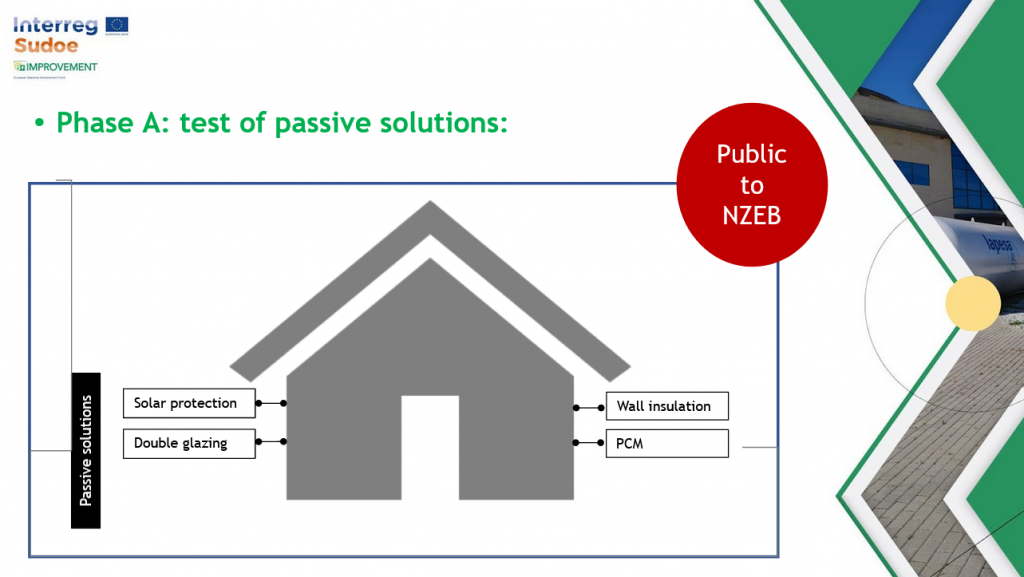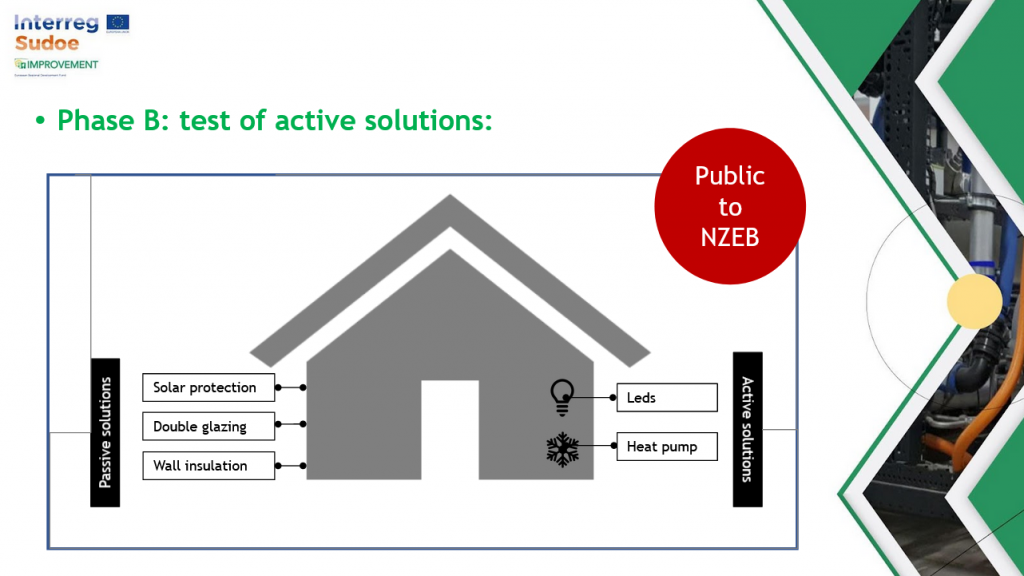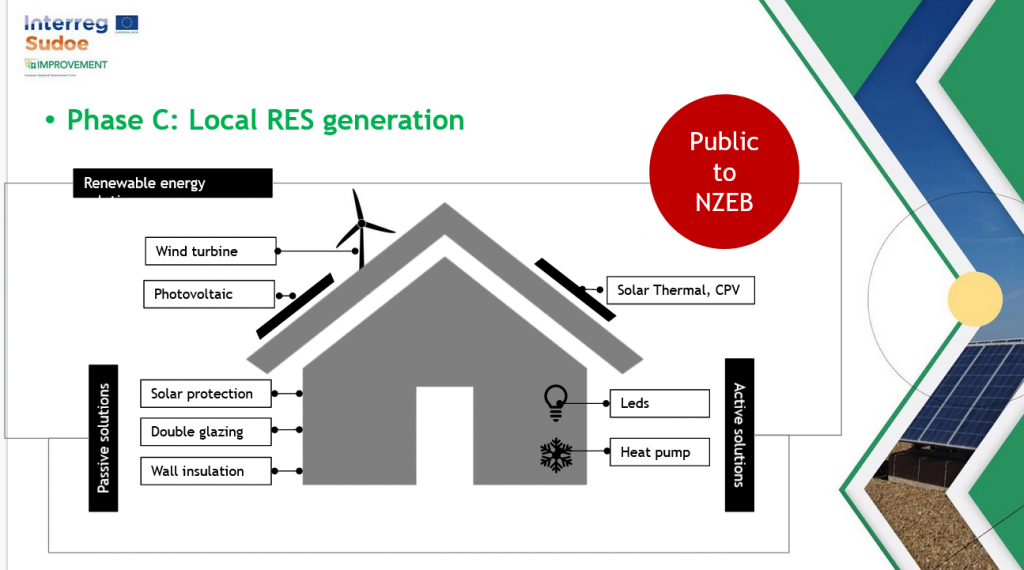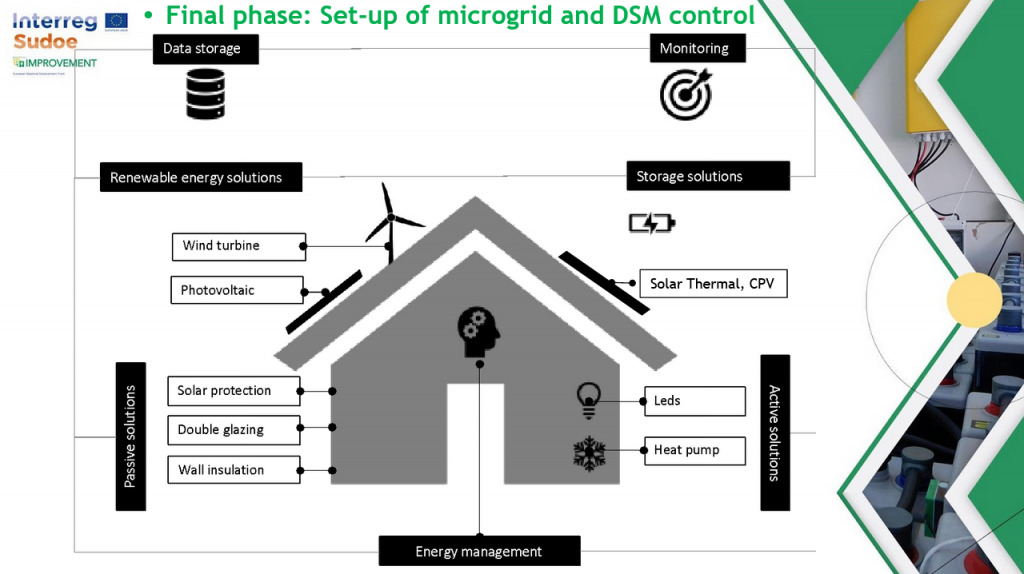IMPROVEMENT project-“INTEGRATION OF COMBINED COOLING, HEATING AND POWER MICROGRIDS IN ZERO-ENERGY PUBLIC BUILDINGS UNDER HIGH POWER QUALITY AND CONTINUITY OF SERVICE REQUIREMENTS”, (SOE3/P3/E0901) has a budget of 2.5 million euros and is 75% co-financed by the Interreg SUDOE programme and the European Regional Development Fund (ERDF) under Priority Axis 3, Low Carbon Economy.
Its overall objective is to convert existing public buildings into nearly zero energy buildings through the integration of renewable energy micro-grids with combined heat, cold and power generation and storage systems, specially designed for Southern European Countries’ climatic conditions.
IMPROVEMENT has a duration of three and a half years (until March 2023).
Description of the Improvement Project
Buildings are responsible for 40% of energy consumption. Recent studies indicate that in the SUDOE region, CO2 emissions associated with the energy consumption of public buildings with high-tech equipment (hospitals, universities, military centres, transport stations, etc.) represent 13% of all existing buildings, with a high summer component.
Most of these buildings were built between the 1970s and 1990s without criteria for the integration of Energy Efficiency (EE) and Renewable Energy (RE). And although numerous projects have been carried out in public buildings to improve efficiency and the implementation of renewable energies, none have been aimed at the specific problem related to improving the integration of energy efficiency, storage and supply with renewable sources in public buildings with high technology equipment (Hospitals, Research Centres, Military Installations, Transport Stations, etc.), where due to the nature of their activity, the quality and continuity of supply for electricity, heating and air conditioning must be considered fundamental aspects.
From this perspective, IMPROVEMENT proposes technical solutions for their conversion to Zero Energy Balance Buildings (nZEB) by proposing new control and integration schemes for microgrids in public buildings with combined generation of heating, cooling and electricity, managing hybrid energy storage systems (electric and thermal). Throughout the project, the necessary elements for the deployment of a new generation of renewable microgrids for the supply of thermal energy (heating and cooling) and electrical energy will be developed.
The truly innovative aspect of IMPROVEMENT consists of providing solutions for the integration of renewable energies and increasing energy efficiency in those public buildings that, due to the use of high-tech equipment, have energy loads with a high sensitivity to losses of quality/continuity of supply with disastrous consequences, such as the loss of supply in an operating theatre or in an airport. These solutions will be developed under the climatic conditions of the SUDOE regions with high air-conditioning requirements in summer.
Microgrids are small, locally self-managed, intelligent electricity and heat distribution systems that can operate either connected to the public grid or isolated from it.
The users of a microgrid will have at their disposal an electrical and thermal grid based on various renewable and storage or high efficiency energy generation sources: solar panels, mini wind turbines, microturbines, geothermal energy, fuel cells, cogeneration systems (generate electricity and heat) and trigeneration (generate electricity, heat and cold), energy storage devices such as batteries or thermal storages, etc.
The main advantage of microgrids is that they improve the quality of supply through voltage regulation, greater savings and less dependence on the distribution grid, as consumption is better controlled and system elements are optimised. In addition, the proximity of the location of the generation sources and the network use of the various energy and heat systems considerably increases improve the overall energy efficiency.
A microgrid also means that energy is used in a decentralised way, which reduces dependence on the conventional power grid.
In failure situations, users could disconnect from the public grid, supplying power to this critical internal demand. Thus, the public grid also benefits from these microgrids, as they improve its operation. Therefore, this technology will improve the quality and continuity of the electricity supply, which are, as already mentioned, fundamental aspects in buildings where the high-tech equipment on which the IMPROVEMENT project is focused.
On the environmental side, microgrids use less energy than current centralised generation and distribution systems, reduce energy losses in distribution, and therefore reduce greenhouse gas emissions that cause climate change. Their use also encourages the implementation of alternative systems based on renewable energies, that are more respectful of nature and the environment.
Objectives
The overall objective of IMPROVEMENT is to turn existing public buildings into near-zero energy buildings by integrating renewable energy microgrids with combined heat, cooling and power generation and storage systems. More specifically, IMPROVEMENT has three specific objectives:
- Development of a system to improve thermal efficiency through the production of solar heating and cooling and the incorporation of active/passive techniques for buildings with zero energy consumption.
- Development of a fault-resilient power management system for microgrids under design criteria of high quality of supply.
- Development of a microgrid energy management system with hybrid energy storage under criteria of minimum degradation and minimum cost of use of the storage system.
Project Activities and Phases
IMPROVEMENT aims to convert existing public buildings into zero energy buildings by integrating combined cooling, heating and power (CCHP) microgrids with neutral clamped inverters using hybrid energy storage systems which will guarantee power quality and continuity of service of sensitive equipment (medical and scientific) while increasing the energy efficiency in these kind of buildings.
The IMPROVEMENT project plans to carry out 2 pilot plants to implement and validate the new developments.
Phases of the Project
Passive solution and strategies play a fundamental role in nZEB design as they directly affect the loads put on the buildings mechanical and electrical systems, and indirectly, the strive for renewable energy generation.

To lower building´s energy demand, in addition to implementing passive solutions and strategies, buildings should also rely on improving energy efficiency of systems, in this case artificial lighting and air conditioning system (heat pump).

After having performed all necessary steps towards lowering building´s energy demand, the last step to be carried out is the integration of renewable systems in the microgrid for local energy generation.
Energy storage: the efficient management of renewable energy requires systems that store the energy generated and allow it to be used on demand.

By setting a detailed monitoring and smart sensors, correct an efficient energy management is achieved by obtaining information on the operation of the building's installations and control parameters, allowing for optimisation actions.

Projects results
IMPROVEMENT will achieve the following results:
- Improving the energetic autonomy of existing public buildings through hybrid storage systems, even under extreme weather conditions.
- Increasing the energy efficiency of public buildings with the integration of near-zero energy building techniques, and renewable energy based cooling and heating systems with thermal storage.
- Development of fault resilient microgrids using inverters with active neutral control to ensure quality of supply in the presence of sensitive loads (high-tech equipment).
- Demonstration in real public buildings.
- Develop regional strategies and implementation plans.
- Develop a business plan to commercialise the developed technology.
IMPROVEMENT develop solutions aligned with priority axis 3-Low carbon Economy, SUDOE programme, implementing following solutions:
Most of the energy consumption of this type of building is due to heating and cooling needs. Fossil fuels are usually used to cover this comfort energy. IMPROVEMENT will develop a technology for the generation of cold/heat with solar energy and its thermal storage, in addition to the inclusion of nZEB techniques.
The project contemplates a 100% renewable energy supply in these buildings both in the mode connected to the network, and in disconnection in those cases of voltage drop in the electricity supply network, without the energy supply system disturbing the quality of supply, thus guaranteeing that there is no damage to high-tech equipment (medical, scientific or technological equipment). Innovation is based on two aspects:
- AUTONOMY BEFORE FAILURES IN THE ELECTRICAL NETWORK. Generator sets are usually used as standby systems. Doing it by batteries would require large rooms to house batteries. The energy density of hydrogen will be used to guarantee autonomy using small spaces.
- SUPPLY QUALITY. It will be guaranteed through the development of a network of IoT sensors linked to inverters with active control of the neutral that minimizes energy imbalances and harmonics.
The energy management system will be based on model predictive control techniques (MPC, Model Predictive Control) with the following objectives.
- USEFUL LIFE OF THE STORAGE SYSTEM. The intermittency and fluctuation of renewable energy systems causes damage to batteries and hydrogen systems that decreases their useful life. To improve the economic competitiveness of these systems, they will be hybridized with supercapacitors, which will minimize degradation processes.
- MAXIMIZATION OF THE USE OF RENEWABLE ENERGIES. The objective is to demonstrate that it is possible to reach 100% renewable consumption both connected and isolated from the network.
The project contemplates the development of regional policies to minimize the emission of greenhouse gases and guarantee 100% renewable consumption in public buildings both connected and isolated from the main electricity grid.
